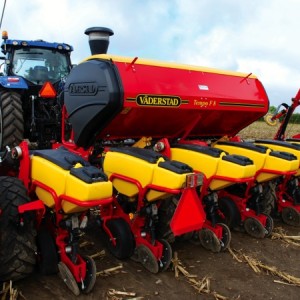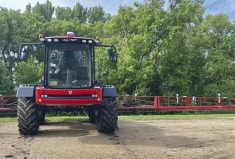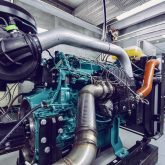One hundred hours. It’s barely more than four days of 24-hour planting, and it can seem like it goes by in a blink of the eye. But depending on farm size, it’s the typical number of hours you get in the spring to plant your corn and soybeans into optimum conditions.
In some years like 2012, of course, the spring gives you more hours than that and it can seem like you have weeks to get the crop into the ground. But then comes a year like 2014 in some parts of Ontario, when 100 hours would have seemed absolute luxury.
Read Also

Joining forces for new innovations
Alberta ranchers Austin and his father Larry Ruud came up with an idea for a new product, the way any…
Even in an open spring, however, the average number of acres per farm continues to climb, putting more pressure on the farm to plant more acres per hour.
It’s this urgency that’s the primary driver behind high-speed planters. Although high-speed drills have been around for 20 years in Europe, the move to high-speed planters for corn is very new to North America.
Now, Amazone, Väderstadt and Horsch have all introduced high-speed corn planters. Horsch brought out its corn planter in 2013, Amazone has had its unit in use in Eastern Canada for at least two years, and Väderstadt introduced its high-speed planter this past summer.
Plus, in a first among North American manufacturers, John Deere introduced its own high-speed unit last February at the National Farm Machinery Show in Louisville, with models available for the 2015 planting season.
Yet many have also questioned planting at nine or 10 miles per hour (14 to 16 km/h); what effect will it have on germination, and ultimately yield? What about stones or uneven terrain?
Field results in Huron
Sonke Claussen began using a high-speed drill (a Väderstadt Rapid) in 1995, the last year he lived in Germany before moving to Canada. Claussen, owner and general manager of Claussen Farms Custom Farming, near Brucefield, Ont., is sold on the technology, and now uses an Amazone EDX 9000 for corn planting. He understands the hesitation that some might have for high speed, but there’s no doubt in his mind of the benefits.
“The concern is seed placement, and I don’t think we expected that the EDX would do a better job at planting by doing it at high speed than what a conventional planter would do, but we expected an equally good job,” says Claussen. In 2014, he made a presentation at the annual conference of the Innovative Farmers Association of Ontario (IFAO), detailing his experiences with the technology, including what he liked, and what he’d like to see changed. “But try as we did, there is no difference. Sometimes one machine wins by one or two bushels more than another one, but it’s nothing more significant that we can see. And just by visually going into the field and seeing the stand emerging and coming up, you don’t see the difference.”

Claussen reported that in two side by sides using the Amazone and a John Deere 1770, the Amazone came in at half a bushel less (179.57 bu./ac.) than the Deere 1770 (180.07 bu./ac.) on one plot. But in the other, it yielded more than two bushels per acre higher than the 1770 (176.45 bu./ac. versus 174.24 bu./ac.). The test plots were all at least 1.6 acres in size.
Claussen’s experience with the Väderstadt Rapid system leads him to want to try the new Tempo, which was showcased at the 2014 Canada’s Outdoor Farm Show, but his desire to work with 12-row units, instead of six- or eight-row configurations like the Tempo keeps him using the EDX.
Yet in spite of the traffic through the Väderstadt-Seed Hawk display and interest shown during its field demonstrations, company representatives are certainly listening to Claussen’s requests.
“You’re definitely buying more capacity with these planters to meet the challenge of getting it done in four or even five or six days,” says Claussen. He adds that the EDX is a more compact machine compared to the 16-row planter he was using. “We’ve gone back to a 12-row machine with the fertilizer tank on the same frame, so it’s a more compact machine, but we have slightly more capacity with the EDX than we had with the replaced 16-row unit. In our case, when we had to be changing fields, we had to change hybrids, and move and travel between customers and our own fields; this is one of the biggest arguments for the EDX. With those tires and having the brake systems on the machine, we can go 50 km/h on the road, and it’s safe.”
Claussen concedes there are limitations to high-speed planters, as well as specific tractor requirements (a minimum of 270 PTO horsepower — although 300 hp is better — plus auto steer and a 40-g.p.m. hydraulic flow capacity). There is also an element of common sense that goes with their use. Concerns about bounces, skips and doubles are reduced by the particular EDX design he uses, says Claussen, including a parallel linkage with 500 lbs. of down-force, rubber cushions on the top parallel arm, 20-inch-gauge wheels instead of 15s that are drawn, not pushed. Yet Claussen expects very stony soils will provide some definite challenges for growers, and that in many of those fields, high-speed planting is likely not an option. (He can still use the planter in those stony fields, although at slower speeds. But even those slower speeds, he says, are faster than with a conventional planter.)
Size doesn’t matter
The notion that high-speed planters took off first in Europe because farms there are smaller is discounted by Gustav Nilsson, market developer and Lars Thylén, concept manager for Väderstadt’s Tempo unit. Both agree the concept is more a matter of performance than size.
“I think both sizes (small and large) will be taking advantage of higher speeds, because you increase productivity,” says Thylén. “In Europe, you use it in less stressful working conditions, because many farmers work quite a few hours in springtime, and can come home a few hours earlier. Plus there is an extra advantage when you have poor planting conditions, where maybe you have three perfect days and during those days, maybe you plant 300 acres, but maybe you plant 600.”
There’s also the anecdotal evidence that as the planting season wears on, farmers tend to increase their speeds in response to challenging conditions. Farmers may start at four miles per hour but as the 100-hour mark approaches the average speed in Ontario starts to increase, often to around 6.5 miles per hour. Even if a grower doesn’t want to push speeds to 10, opting instead for eight miles per hour, that’s still double the starting speed and about 20 per cent faster than the “rush hours.”
Nilsson concedes that many have expressed doubts about the high-speed concept, adding that initially, there were doubters when Väderstadt unveiled its high-speed drill in 1990.
“People were saying we can’t drill in double the speed,” Nilsson says. Now, Tempo must answer similar doubts. “It’s been a great success,” Nilsson says.
Measuring accuracy
Key to overall performance is the planter’s coefficient of variation for placement accuracy. In other words, how close does it come to actually placing the seed where you want it?
On the Amazone EDX, the coefficient of variation (CoV) with its Xpress singling and placement system has been found to be virtually the same as conventional systems operating at slower speeds.
“They were able to have precision equal for uniformity of spacing of the grain, and after emergence, it’s as good if not even better at 15 km/h than a conventional planter,” says Sam Abourjeily, sales manager for Amazone products for Farm Fleet in Eastern Canada.
That includes working in stony fields, Abourjeily says, and it also includes being able to stand up to the stresses of the planting season without breaking down.
“People who have been used to planting from their parents, brother or grandfather and using technology at a much slower pace will always be skeptical that this technology at high speed will give them the same ability,” says Abourjeily. “They have a little bit of difficulty visualizing the advance of technology and the design that is built into these machines to make them capable of working as well, if not better under less-than-optimal conditions.”
Each manufacturer has its own key to success
It’s fascinating that there can be so many different technical approaches for obtaining the speed and especially the accuracy needed for high-speed planters. In fact, that’s what needs to be stressed. It isn’t just the speed at which the planter operates, it’s the accuracy of the delivery of the seed into the trench that’s just as important.
“Anybody can take a planter and plant at high speeds, you just won’t plant accurately with previous technology,” says Steve Reynolds, John Deere’s solutions specialist for southern Ontario. “We can plant faster because we’ve eliminated that seed bounce in the tube that leads to poorer spacing.”
In the Väderstadt Tempo, it’s the Gilstring seed meter that provides precision and accuracy at higher speeds. With this unit, a combination of seed metering precision and the delivery of the seed through its Power Shoot pressure gradient sends the seed to the trench with a high level of accuracy, no matter the speed, slope or amount of vibration.
In the Amazone EDX, it’s a unique singling drum on the Xpress singling and placement system that provides the all-important coefficient of variation (CoV). The singling drum is adjustable, from six to 16 rows, and carries seed through the stripper finger adjustment, singulating the seed as it’s channelled from the hopper into the seed tube. From there, the Xpress catcher system forms and firmly places the seed into the furrow, preventing it from rolling out of position, even under less-than-favourable conditions.
With the John Deere ExactEmerge row unit, the key feature is the brush belt mechanism. After the seed is singulated, whether it’s corn or soybeans, it travels from the seed meter to a level where it’s just above the trench. The brush belt actually places the seed in the middle of the trench, and uses two separate motors. The first drives the meter and sets the seed population. The second drives the brush belt at the exact same speed as the planter, but in the opposite direction. This provides a “dead drop” so the seed is essentially travelling at zero miles per hour as it falls into the trench.
“The big change is the accuracy,” says Reynolds. “You want great accuracy in the field, you want good singulation, and good spacing and a good coefficient of variation, and we’ve been able to deliver it.
“If you can increase your productivity by 50 per cent,” Reynolds says, “that’s a huge increase, and that benefit alone is very valuable to the producer.”
For more information, visit the following links:

















